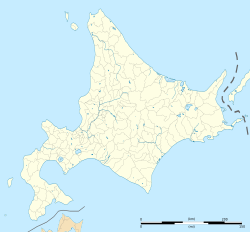Top Qs
Timeline
Chat
Perspective
Engaru, Hokkaido
Town in Hokkaido, Japan From Wikipedia, the free encyclopedia
Remove ads
Engaru (遠軽町, Engaru-chō) is a town in the Okhotsk subprefecture of Hokkaido, Japan. The name comes from the Ainu place name Inkar-us-i ("overlook-always doing-place"), meaning a lookout point.[1][2]
This article needs additional citations for verification. (August 2013) |
Remove ads
On October 1, 2005, the towns of Ikutahara and Maruseppu, and the village of Shirataki, all from Monbetsu District merged into the expanded town of Engaru.[3] As of September 2016, the town has an estimated population of 20,757.[4] The total area is 1,332.32 square kilometres (514.41 sq mi),[5] making it the fifth largest municipality in Hokkaido.[6]
Engaru is known as the place where Aikido originated, in the Shirataki area.[7] It is also where the largest cosmos flower park in Japan is located. An Upper Paleolithic site at Shirataki Site Group is the source of some Yubetsu technique stone blades dating from approximately 13,000 years ago.
Remove ads
History
- 1869: Current town area was part of the Wakayama Domain (or Kishū Domain) jurisdiction.[8] There were expanses of plains.
- 1896: The Church of Christ in Japan established the Hokkaido Comrades Education Association, and planned a Christian university at Engaru.[2][9]
- 1897: On 7 May, the first immigrant party[2][8] of the Hokkaido Comrades Education Association arrived in Engaru, the first party to immigrate at Engaru. But the final construction of the university's plan did not materialize.[2][8][9]
- 1919: The village of Engaru is split off from Kamiyūbetsu (now the town of Yūbetsu).[8]
- 1925: The village of Ikutahara split off, becoming its own town in 1934.[8]
- 1934: Engaru becomes a town.[8]
- 1946: The villages of Maruseppu (later becoming a town) and Shirataki are split off.[8]
- 2005: The towns of Engaru, Ikutahara, Maruseppu, and the village of Shirataki merge to form the new town of Engaru.[3]
Remove ads
Notable geography
- Mountains: Mt. Murii, 1,876 metres (6,155 ft); Mt. Hirayama, 1,771 metres (5,810 ft); Mt. Shiyūbetsu, 1,688 metres (5,538 ft); Mt. Chitokaniushi, 1,446 metres (4,744 ft); Mt. Kitami-Fuji, 1,306 metres (4,285 ft)
- Major rivers: Yūbetsu River; Ikutahara River; Maruseppu River; Setose River; Shanafuchi River; Murii River
- Waterfalls: Yamabiko no Taki, Rokumei no Taki, Jūsan no Taki, Shirataki
- Others: Gambōiwa (瞰望岩), a rocky hill made of underwater lava of andesitic (hyaloclastite) which was spewn out from an underwater volcano in the Miocene Epoch of the Neogene Period in the Cenozoic Era (about 7 million years ago) with volcanic sandstone conglomerate. The top of the cliff is about 78 metres (256 ft) high.
Remove ads
Industry
The major industries are commercial forestry, wood processing, and agriculture.
In the past, Engaru Station was the intersection of the Nayoro Main Line (closed in 1989) and the Sekihoku Main Line. It had an important position in business and overall development.
Climate
Summarize
Perspective
According to the Köppen climate classification, Engaru has a humid continental climate (Dfb) with warm, rainy summers and extremely snowy, long, and cold winters.
Remove ads
Gallery
This section contains an unencyclopedic or excessive gallery of images. (August 2013) |
- Gambōiwa
- View from Gambōiwa
- Town area in front of Engaru Station
- Preserved forest railway locomotive at Maruseppu
- Setose Spa
- Ikutahara Spa "North King"
- Kita-Taisetsu ski area
- Hokkaido Prefectural Engaru High School
Sister cities
 Bastos, São Paulo, Brazil
Bastos, São Paulo, Brazil Moirans-en-Montagne, Jura, France
Moirans-en-Montagne, Jura, France
Notable people
- Tomonori Kogawa (born 1950) animator, and animation director of 1980 TV series Space Runaway Ideon[12]
- Masami Tanaka (born 1979) a former swimmer[13]
- Morihei Ueshiba (1883 - 1969) the founder of Aikido, leading Kishū Settlers Group at Shirataki area from Tanabe[7]
- Yoshikazu Yasuhiko (born 1947) animator, manga artist, and character designer of 1979-1980 TV series Mobile Suit Gundam[14][15]
See also
- Engaru Shimbun - the regional newspaper
References
External links
Wikiwand - on
Seamless Wikipedia browsing. On steroids.
Remove ads














